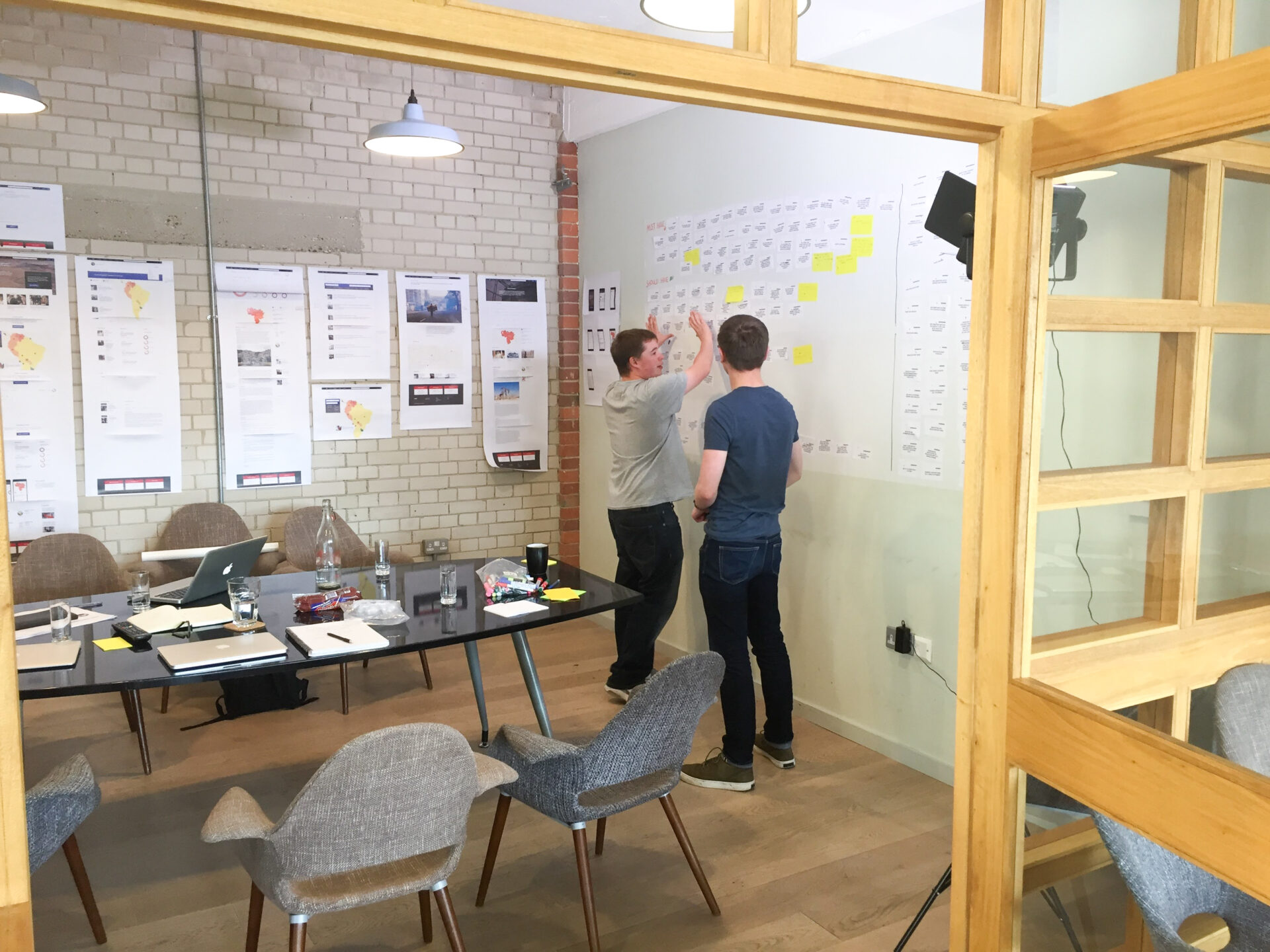Stakeholder strategies for designing better UX

Designing a unique digital experiences presents its own set of challenges and the tools to deal with those challenges. Design thinking isn’t having just one opinion/approach, like the L-wrench you get with Ikea furniture. Just as a craftsman relies on a well-stocked toolbox to tackle any job, product and design teams need a diverse set of strategies. By having a range of techniques at their disposal, teams can adapt to the specific needs of each project, ensuring that they deliver solutions that solve real problems and provide lasting value.
This article explores three essential strategies that belong in every product and design team’s toolbox: the art of saying “no,” asking better product discovery questions, and conducting pre-mortems. These techniques help teams focus on what matters most, uncover deep insights, and anticipate potential challenges. By mastering these strategies, teams can make informed decisions that lead to successful outcomes and better designs.
Strategy 1: The Art of Saying “No”

Saying “no” is a powerful tool in digital strategies, as it allows teams to prioritise initiatives that align with business goals and target audience needs. Declining projects or features that do not contribute to the overall vision, companies can focus on what drives value.
However, the importance of saying “no” extends beyond just project selection. It also applies to fostering a culture that encourages open and honest feedback, even when it involves criticism. The cautionary tale of Humane AI Pin illustrates the dangers of a company culture that suppresses critical feedback.
According to a report by The New York Times, Humane’s founders “preferred positivity over criticism, leading them to disregard warnings about the AI Pin’s poor battery life and power consumption.” This culture of avoiding negativity went so far as to result in the dismissal of a senior software engineer who questioned the product’s readiness for launch. The founders even stated in a staff meeting that the employee had “violated policy by talking negatively about Humane.”
By creating an environment where employees feared retaliation for expressing concerns, Humane missed valuable opportunities to address critical flaws in their product. This ultimately led to a disastrous launch, with the AI Pin being universally panned by reviewers and customers alike.
A word of caution about saying no, its a currency in the politics of shared decision making. Meaning its value is useful when spent wisely. A good well informed NO should be backed up by at least one of the following factors:
Misalignment with business goals
Misalignment with business goals occurs when a company pursues initiatives or strategies that do not support its core objectives or values. In 2011, Netflix fell into this trap when it announced plans to split its DVD rental and streaming services into two separate companies, with the DVD rental business being called “Qwikster.” This decision was met with significant backlash from customers and failed to align with Netflix’s core business goal of providing a seamless, integrated entertainment experience. Recognizing this misalignment, Netflix quickly canceled the Qwikster plan and refocused on its unified streaming and DVD rental strategy, which has proven successful in the long run.
Target audience mismatch/missing out
Target audience mismatch occurs when a company’s product or service fails to align with the needs, preferences, or demographics of its intended customer base. In the early 2000s, CuePilot, a specialised product used to direct big live shows like the Eurovision Song Contest, fell into this trap by primarily focusing on the Nordic market. By limiting their target audience to a specific region, they were missing out on potential customers worldwide. Recognizing this mismatch, CuePilot expanded their product to appeal to television producers globally, increasing their potential customer base from 719 to 10,000 and growing their total addressable market from $29 million to $400 million. This example demonstrates the importance of identifying and addressing target audience mismatches to unlock growth opportunities and expand a company’s total addressable market.
Opportunity costs
Opportunity cost in design projects arises when choosing to pursue one project or feature means forgoing the potential benefits of alternative options. When making design decisions, it’s crucial to consider the resources required and the potential return on investment to ensure the most valuable opportunities are pursued. For example, in 2008, Polaroid was faced with a decision to invest in either improving its traditional analog instant camera technology or exploring the emerging digital photography market. At the time, Polaroid had limited resources and needed to choose wisely. The company ultimately decided to focus on enhancing its analog instant cameras, allocating significant resources to this project. However, this decision proved to be a costly mistake, as the digital photography market exploded in popularity, and Polaroid’s analog technology quickly became obsolete. By failing to recognize the opportunity cost of investing in analog technology over digital, Polaroid missed out on the massive potential of the digital photography market and eventually filed for bankruptcy in 2001.
Criticism will and should happen when designing something meant for the market. It can be either healthy criticism internally or it can be the job of your customers who will definitely criticise a poorly thought out product.
Strategy 2: Asking Better Product Discovery Questions

Creating successful products and experiences requires a deep understanding of your target audience’s needs, preferences, and pain points. This is where product discovery comes in – a process that helps teams uncover valuable insights and inform strategic decision-making. By asking the right questions and employing effective research techniques, companies can identify opportunities for innovation, improvement, and growth.
Consider a hypothetical scenario where an e-commerce company specialising in eco-friendly clothing wants to improve customer satisfaction and increase sales. They start by asking surface-level questions:
- How can we make our website more attractive and user-friendly?
- What new product categories should we add to our offerings?
- How can we streamline the checkout process to reduce cart abandonment?
While these questions are relevant, they don’t address the core issues that may be affecting customer satisfaction and sales. By asking more specific, probing questions, the team can uncover deeper insights:
- What are the primary reasons customers choose our eco-friendly clothing over conventional alternatives?
- How do customers perceive the value and quality of our products compared to competitors?
- What are the most common concerns or hesitations customers have when considering a purchase?
- How well do our product descriptions, images, and reviews address customer needs and expectations?
- What post-purchase experiences (e.g., packaging, shipping, customer support) influence customer satisfaction and loyalty?
- How can we better educate customers about the environmental impact of their clothing choices?
- What role do our brand values and mission play in attracting and retaining customers?
Through exploring these deeper questions, the team realises that customers are drawn to the company’s eco-friendly mission but often struggle to justify the higher prices compared to conventional clothing brands. They also discover that customers are confused about the specific environmental benefits of the company’s products and manufacturing processes.
Based on these insights, the team decides to focus on:
1. Developing more compelling and transparent content that highlights the unique value proposition of their eco-friendly clothing.
2. Investing in customer education initiatives to raise awareness about the environmental impact of the fashion industry and the benefits of sustainable clothing choices.
3. Exploring ways to optimise their supply chain and production processes to reduce costs without compromising quality or sustainability, allowing them to offer more competitive prices.
By addressing these core issues, the company is better positioned to attract, satisfy, and retain customers.
Want to uncover some insights with your organisation? By participating in our workshops and design sprints, companies can accelerate their product discovery process, reduce the risk of investing in the wrong initiatives, and create digital experiences that truly resonate with their target audience. These focused, high-impact sessions are an invaluable tool for any organisation looking to drive customer satisfaction, loyalty, and growth.
Asking better product discovery questions is a critical strategy for uncovering the true nature of the problem and positioning your product to deliver lasting value. By digging deeper and exploring the underlying issues, teams can gain valuable insights that inform product development, marketing, and customer support strategies.
Strategy 3: Conducting a Pre-Mortem

A pre-mortem is an exercise that helps teams anticipate and prepare for potential challenges before a product launch. By imagining worst-case scenarios and developing contingency plans, companies can minimise risks and ensure a smooth rollout.
I personally have been using this technique more in projects and while it has been useful in addressing potentially fatal flaws early, the technique can be over used. If it is, product “danger” will be lurking in the shadows at every decision. Also, your opinion won’t hold as much weight (or at least that’s been my observation). My recommendation, use this technique as much as needed within the context of making critical design choices. The best time to conduct a pre-mortem is during the planning phase of a project, well before the actual launch. The type of data that this technique should be paired with is in depth research data, market and user. This will give you a good measure of the expectations of the users and what competitor features are working and which ones aren’t. This allows teams to proactively address potential issues and make necessary adjustments to the product, strategy, or execution plan.
Conducting a pre-mortem offers several benefits:
- Planning responses to problems with a clear head: By anticipating challenges before they occur, teams can develop effective strategies without the pressure of an ongoing crisis.
- Ensuring team alignment: Pre-mortems allow teams to discuss potential issues and agree on the best course of action, fostering a unified approach to problem-solving.
- Preventing problems before they start: By identifying potential threats early on, teams may be able to address them proactively, preventing issues from arising in the first place.
- Establishing “pull the plug” criteria: During the pre-mortem, teams should agree on specific scenarios or metrics that would indicate the need to stop investing in the project. This “pull the plug” criteria helps teams make difficult decisions objectively, based on predefined thresholds rather than emotions or sunk costs. It’s not about quitting, but rather committing to a process that prioritises the company’s resources and long-term success.
A pre-mortem is not the introduction of negativity or a quitting mindset but embracing the process of design and accepting that you and/or your team may have been wrong. Let me put it a different way; if you’ve ever ridden in a car, there’s a good chance you’ve worn a seat belt (or at least should have). Do you plan on the car crashing? NO! You are taking a precaution, not preparing for the worst.
Conclusion
Focusing on what matters most in digital strategies requires a combination of saying “no” to distractions, asking better product discovery questions, and conducting pre-mortems before launch. By embracing these strategies, businesses can prioritise high-impact initiatives, uncover valuable insights, and anticipate potential challenges. This focused approach leads to improved performance, higher conversion rates, enhanced brand reputation, and ultimately, the delivery of exceptional value to customers.
With thanks to Jason Goodman on Unsplash for the photo ❤️.